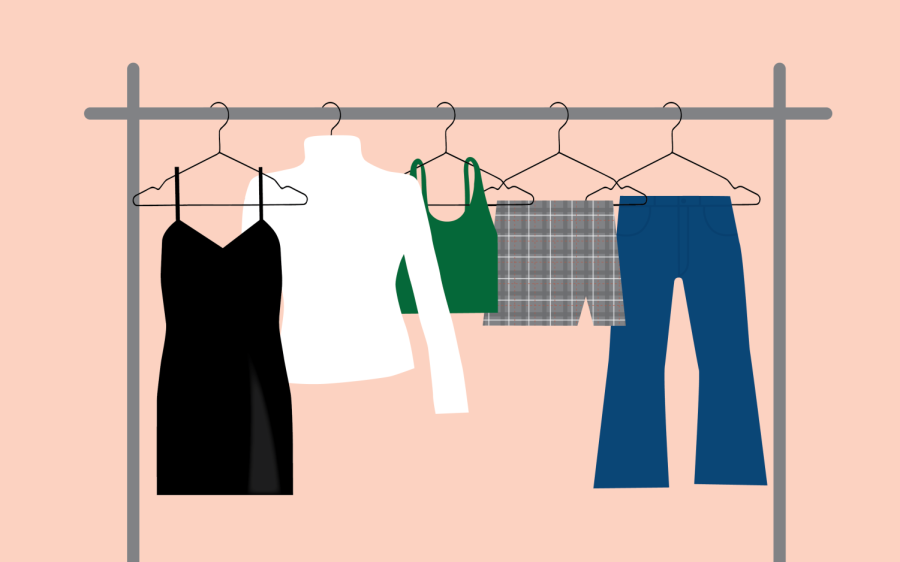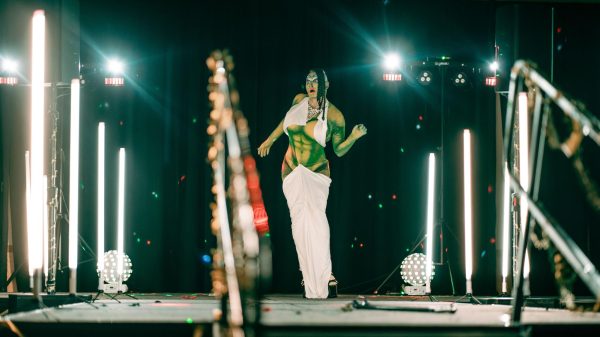The Death of the 30 Year Trend Cycle
Searching #fashiontrend on TikTok will yield over 1.8 billiontrend predictions, curated aesthetics and closet hauls. With millions of creators introducing new trends and naming new aesthetics every day, consumers are bombarded with oscillating ideas of what’s in and what’s out.
Pete Rush, an adjunct faculty member in the arts department, puts fashion trends into perspective by weaving a timeline of trend cycles from B.C. to modern times. In early Greek, Roman and Egyptian history, the types of clothing lasted nearly six centuries with little variation.
“And then you get to the Middle Ages and that lasts about four centuries. And then you get to the Elizabethan Era and you get a century and a half. 1600s—one century. 1700s—one century. You get to the 1800s and things start to accelerate [into thirty year cycles]…but then you get to the 21st century and a trend can last six months, or it can last three weeks,” Rush said.
Historically, fashion trends have come in 30 year waves. In the 1980s, there was a resurgence of 1950s silhouettes and patterns, as polka-dots and peplum tops hit runways worldwide. In the 2000s, flared pants and fur-trimmed coats paid homage to some of the biggest crazes in 1970s apparel. In 2022, we are seeing the revitalization of trends as recent as the mid 2010s, as #tumblr2014 has seen a spike in views on TikTok.
What has killed the thirty-year trend cycle? Some believe that social media is to blame for the creation of micro-trends. Due to social media’s ability to produce rapidly created content, it is able to come up with its own quickly changing catalog of the latest fashion trends. Adjunct Professor of Communications and KOMO News Anchor and Reporter Tyrah Majors, argues that social media has unprecedented persuasive power.
“We’ve seen creators and individuals gain traction for a short period of time…and other creators latch on to the trend so that they can have the same success rate. It’s a similar concept with fashion and micro-trends,” Majors said. “Remember when Y2K style skinny jeans suddenly became ‘uncool’ and wide-legged pants from the 1990s became the cool thing? Well, someone had to bring the look back. Most likely influencers—they often start these trends on social media and are seen by hundreds of followers. This leads to the consumption of the ‘cool thing’ for a period of time.”
In the past, magazines, TV shows, movies and paparazzi pictures of celebrities were responsible for influencing the next seasons of style. According to Rush, fashion influence is becoming diluted as more individuals add their unique looks and use social media to share them.
“Every person is their own little celebrity,” Rush said. “Every person has their own brand, their own style, their own cache. And it’s really easy to create that persona.”
Fast-fashion has been the easiest way for consumers to follow along with trends set by social media, as they are able to produce new styles at a rapid rate. The fast-paced production has caused major pollution; fast-fashion is one of the top polluting industries today.
While the environmental consequences are difficult to ignore, fast-fashion also has a role to play in fostering body inclusivity, according to Second-year Public Affairs major Anabella Vucci.
“I gravitate towards the negative aspects of fast-fashion, which are mainly in the realm of sustainability, and the overconsumption of clothes is inherently bad. However, fast-fashion has opened up a world in which people who are mid-sized and plus-sized can follow along with trends,” Vucci said.
In the past, fashion has notoriously been marketed to thin, straight-size people, but as fashion content has sped up in production, so has the representation of different body sizes in each new trend created.
“That possibility [diverse size representation]was not available for people in the thirty-year trend cycle,” Vucci said.
Majors seconds Vucci’s view on the potential positives of the modern trend cycles, and believes that sustainable fashion can coexist with trend-following.
“‘Micro-trends’ develop[ment] is a good thing for the future of sustainable fashion. I believe it is the reason thrift shops and vintage-wear shops are so popular. People are looking for second-hand clothes not only because it’s more affordable, but because these shops serve as sort of a capsule of trending fashion in the digital age,” Majors said.
Micro-trends are a direct result of increased fashion media, and as social media users continue to rise in numbers, it is unlikely to go away. As social media continues to create trends at an accelerated pace, it is up to consumers to make their own decisions regarding their personal style and sustainability of their clothing consumption.










